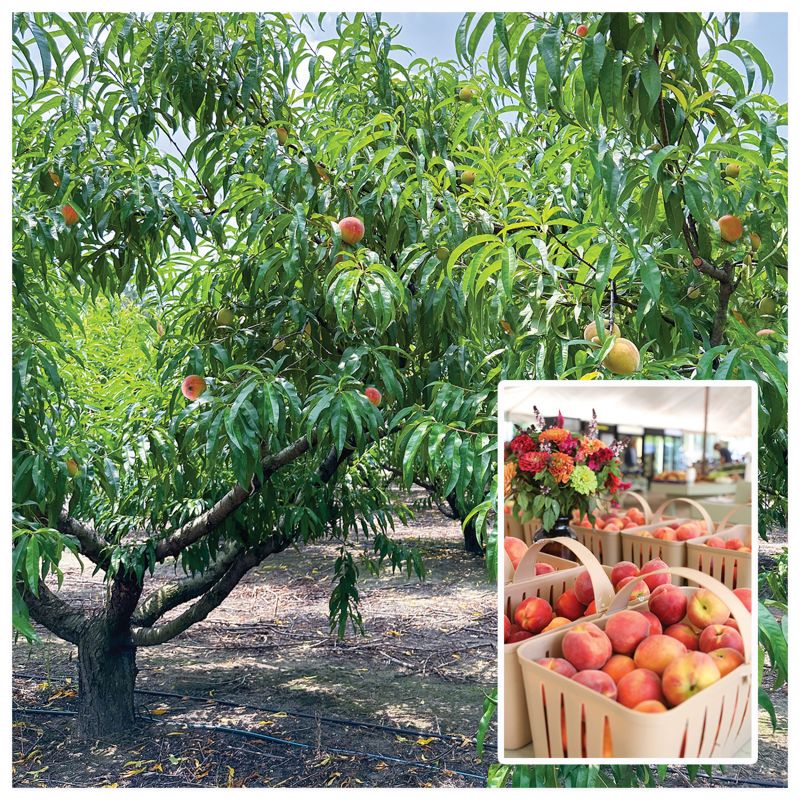Get a list of nearby farm stands and markets to buy the juicy gems, plus an update on a local heirloom variety that may be making a comeback

Did you know South Carolina far outpaces Georgia (aka “The Peach State”) in production three to one in a typical year? Get ready for this season’s bounty with a bushel of recipes, a list of nearby farm stands and markets to buy the juicy gems, and an update on a local heirloom variety that may be making a comeback
A Cling of the Past?
While it doesn’t own the moniker “The Peach State,” South Carolina grows more tons of the stone fruit per year than Georgia and has done so for decades. Today, the bulk of our state’s fruit comes from the Piedmont, but the Lowcountry has its own distinctive peach history.
Here, in the mid-18th century, botanist and seed broker Martha Logan maintained a garden and nursery on Trott’s Point (a tract of land on the east side of the peninsula, cornered off by King and Hassel streets) that contained peaches, nectarines, and apricots, which she sold to area residents. These stone fruits had to be imported (Logan ordered her seed stock from England), for only a small variety of native fruit grew here at the time: paw paw, shadbush, persimmon, mayhaw, sand plum, and wild black cherry. Peaches, in fact, originated in China, and Spanish settlers brought them to the Western Hemisphere.

(Left) Commercial breeding has favored peaches with firm flesh, less fuzz, and a pit that separates easily from the fruit (freestone), making some heirlooms, such as the lemon cling (upper right), nearly obsolete. A movement by Slow Food Charleston is hoping to bring them back to the state; (Right) vintage South Carolina peach carton labels.
Sometime prior to the Revolutionary War, Logan received a vibrant yellow-fleshed peach of robust growth and luscious texture. Called the “lemon peach” or “lemon cling” (short for “clingstone,” the type of stone fruit whose flesh “clings” to the pit), it would soon spread to orchards across the country and be immortalized in a brandy-infused dessert. In South Carolina’s first cookbook, The Carolina Receipt Book: or, Housekeeper’s Assistant, by A Lady of Charleston (1832), “Peaches in Brandy” were made by simmering the fruit with sugar and the booze over the stovetop. Compared to other varieties, the lemon cling was “the most juicy and highest flavoured of all the Clingstone peaches” and stood up the best to brandy, according to Declaration of Independence writer Timothy Matlack, who sampled the fruit at Thomas Jefferson’s Monticello and whose description was cited in Peter J. Hatch’s book The Fruits and Fruit Trees of Monticello (UVA Press, 2007).
The peach Matlack was referring to was likely “Kennedy’s Carolina,” a variety named after Robert Kennedy, a New Yorker who visited Charleston in 1788 and took one of Logan’s peaches from the Holy City up North. In New York, Kennedy enlisted pomologist William Prince, the greatest nurseryman of the day, in propagating the lemon cling at his Flushing Landing nursery. Soon after the Civil War, the canning industry seized it, and or about half a century, lemon clings were the most popular canned peach in the country.
Meanwhile, here in its hometown, the fruit had not been grown since the 1880s. The city’s chief nursery, Geraty Seeds in Yonges Island, offered 35 peach varieties in 1907, but the lemon cling was absent from the list. However, in December 2017, Slow Food Charleston started an effort to fund the restoration of the lemon cling. With seed stock and guidance from horticulturists at Monticello, more than 100 samplings were distributed to the Charleston Parks Convervancy, Green Heart Project, small growers, and home gardeners.
A survey of recipients conducted this April indicated that results were mixed. Some of the saplings went unplanted and a late freeze in mid-March 2023 stunted growth (for all peach production). That said, a few planters reported significant growth this season. One of them, Rodger Winn of Rodger’s Heirlooms near Columbia, expects a full crop this year from the six trees he planted in 2017. He’s even shared scion wood from the trees with Monticello and others and hopes to one day make trees available to home gardeners.

Find Shuler peaches at the farmstand in Ridgeville and at the Mount Pleasant and downtown farmers markets.
Clingstone vs. Freestone
Peaches come in thousands of varieties that are classified into three main categories
1. Clingstones are the first peaches of the summer—available mid-May to mid-June—and are characterized by how the pit “clings” to the fruit. They’re typically sweeter and softer, making them best eaten out of hand. Find them at farm stands, rather than grocery stores.
2. Freestones are the baker and home canner’s friend with flesh that separates easily from the stone; available from late July to early September.
3. Semi-freestones are a hybrid variety whose pit becomes easier to pull away as the peach ripens. Find them mid-June to mid-July.

(Left to right) Stono Market, John’s Island & Rosebank Farms, John’s Island.
Get Your Peaches Here
Find South Carolina-grown peaches at these farm stands and markets:
Blackbird Market
1808 Bohicket Rd., John’s Island. Monday-Saturday, 10 a.m.-7 p.m. (843) 559-0193, blackbirdmarket.net
Boone Hall Plantation & Gardens
Willie’s Roadside Market, 2434 N. Hwy. 17, Mount Pleasant. Monday-Saturday, 10 a.m.-
5 p.m. (843) 856-5366, boonehallfarms.com
Rosebanks Farms
5018 Kiawah River Dr., John’s Island.
Daily, 9 a.m.-6 p.m. rosebankfarms.com, @rosebank_farms
Shuler Peach Company
582 Hwy. 78, Ridgeville. Daily, 10 a.m.-6 p.m. (803) 759-0089; shulerpeachcompany.square.site; @shulerpeachcompany
Stono Market
842 Main Rd., John’s Island. Tuesday-Wednesday, 9 a.m.-6 p.m.; Thursday-Saturday, 9 a.m.-9 p.m. (843) 559-9999;
stonofarmmarket.com, @stonomarketandtomatoshedcafe
Start a Sapling from a Peach Pit
From germinating to planting, learn how to grow a tree from your peach stone at charlestonmag.com.
Images by (peach illustration) Otto Wilhelm Thomés; (Peach blossoms) Keith Mearns, (peaches) Rodger Winn, & (parade float)
Joe F. Jordan & courtesy of (fruit stand) South Carolina Historical Society; & Amanda Bouknight. Recipe photographs by Helene Dujardin.